35 years of Super Mario on Game Boy: a hopeful Game Boy Collection
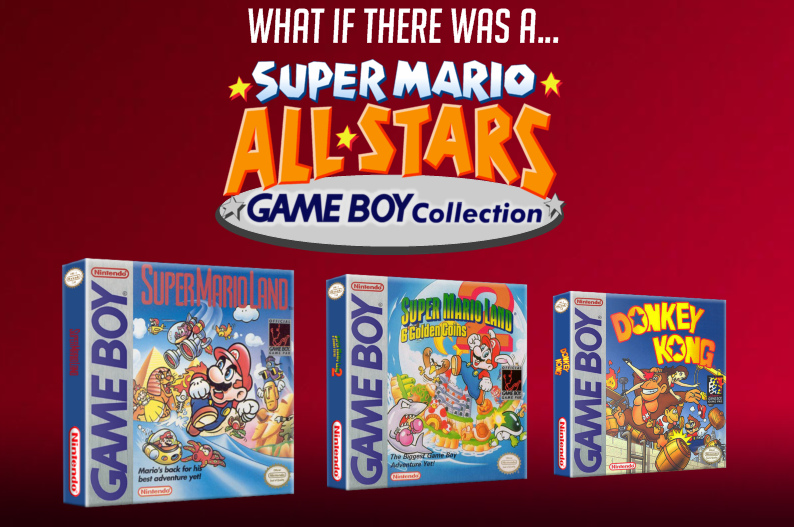
 fter months upon months of rumors about their existence, Nintendo finally put the scuttlebutt to rest, and officially revealed the Super Mario 3D Collection, a compilation of Mario’s iconic three-dimensional outings spanning three generations of hardware, all packed into one convenient title.
fter months upon months of rumors about their existence, Nintendo finally put the scuttlebutt to rest, and officially revealed the Super Mario 3D Collection, a compilation of Mario’s iconic three-dimensional outings spanning three generations of hardware, all packed into one convenient title.
Aside from the glaring omission of Super Mario Galaxy 2 though, something else has been really bothering me; it’s something that seems to have been overlooked by a majority of the community, myself included, and only really came to me after a certain title was coincidentally teased in the last Nintendo direct prior to this Mario-centric one…
Why aren’t there any special curative efforts for the Plumber’s classic Game Boy stints? — Where has all of the love gone for Mario’s portable adventures?
While there may have been an argument over just how much love these titles may have fostered from the Mario fandom, the hype over the recent output of portable tributes mobile device has left a lasting impact. Tributes like the Analogue Pocket, the Mega Man Zero Collection, and the soon-to-be-launched Collection of SaGa has proven that the library of software on Nintendo’s signature on the go device is still very much revered. Among these titles, are some of the finest Mario titles developed by the Big N, and if the 35th anniversary of the Nintendo’s Italian Stallion is any indication, there’s no better time than now to capitalize on re-releasing his Black-&-White classics onto their Console-Portable hybrid while the iron is still hot for the little thing.
Even though Mario has appeared in dozens of titles for various iterations of the Game Boy line, it isn’t that difficult to land (see what did there) on what the De Facto entries should be for such an assortment. Super Mario Land alone helped put the Game Boy on the map with over 18 million copies sold since it launched alongside the hardware in 1989; yet the game has only seen one re-release on the 3DS, with that revision boasting minimal upscaling at best over its original version. Though that angle within itself is the question though; with so much of their charm hinging on the minimalist production values to circumvent the limitations of the original Game Boy, just how produced could this proposed compilation actually be?

I mean, let’s face it—aside from the minor quality of life improvements Super Mario All-Stars offered, the biggest attraction to the package was the remastered presentation that took full advantage of the 16-bit horsepower that the SNES had to offer. The improved presentation alone is why SMAS has endured the test of time while other contemporaries like Ninja Gaiden Trilogy have been given the cold-shoulder. The most dated of the NES lineup, the original Super Mario Bros, was reimagined into an absolutely stunning world of color and definition that its 8-Bit counterpart could never execute. The NES was arguably at its peak with Super Mario Bros 3, yet the improvements the SMAS version made to the presentation have almost resonated more with the intended style of the game the initial software could ever convey. Then there’s the music; if you thought the classic chiptunes sets were bangers, just imagine how much sweeter they sound when composed with the Sony SPC700 soundboard of the SNES. The range of harmonies afforded by the expanded channels of the system gave the team a lot more instrumentation to work with, resulting in this Calypso-like sound font to it that just adds that much more vibrancy to the package.
Where the Plumber’s 8-bit excursions pushed what they could out of their platform, however, the Game Boy titles were developed with the philosophy of less being more; would these games retain their enigmatic nuance if they were to receive the same treatment?—then again, who’s to say that they need the same kind of bells and whistles…
Despite the visual and audible acclaim that Super Mario All-Stars is known for, if the trailer for Super Mario 3D Collection is any indication, the argument for technical upgrades might not be as big as a barrier as most would believe.
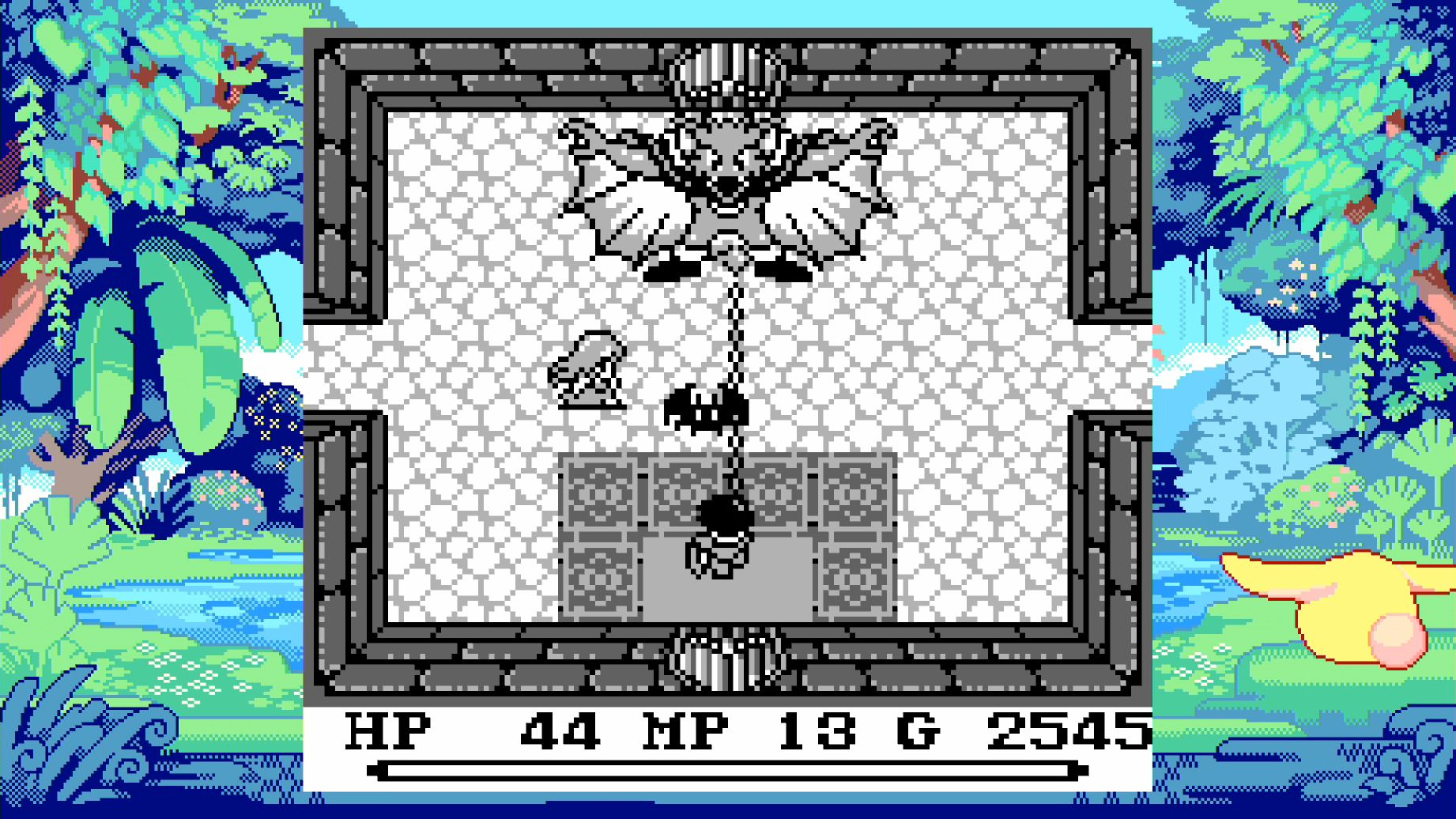 Here's Final Fantasy Adventure on Collection Mana, upscaled to 480 X 640 pixels
Here's Final Fantasy Adventure on Collection Mana, upscaled to 480 X 640 pixels
I mentioned Collection of SaGa earlier, but it’s important to mention its not-so-distant cousin, Collection of Mana, which not only included the Super NES/Famicom games Secret of Mana and Trials of Mana but the Game Boy title, Final Fantasy Adventure, and why the development work put into it is such an integral talking point for this discussion. Developed in part with Retro Gaming Dignitaries of Japanese classics, M2, the emulation of Final Fantasy Adventure, in particular, is unique as it emulates a display that goes beyond the standard pixel resolution of the Game Boy. The Game Boy natively outputs a resolution of 160 x 144 Pixels, which is why it appears windowed when put on a standard 4:3 display—M2 not only gives players this option, but an upscaled screen at 480 X 640 pixels, outputting at 720p undocked, and 1080p docked!
The pixel density is multiplied three times when upscaled without any sign of shimmering, though to be fair, there are aren’t more 10 colors on-screen when the color is enabled, similarly to how Game Boy games were colorized on the Super Game Boy or Game Boy Color, but it’s still none the less, incredibly impressive. 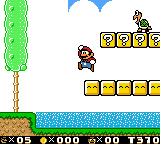 Super Mario Land 2 DX in actionOffering a sharp black-and-white filter, GBC color filter, and even a Monochrome green color scheme that implements a subtle softness to its resolution to simulate the native blur of the original Game Boy’s display, the presentation options available are incredibly flexible. The Game Boy fandom has a wide range of purists, and to cater to those who want to return to their nostalgic roots, or videophiles that are looking to enhance the graphical output of the classic the highest quality available is a level of forethought that should be applauded.
Super Mario Land 2 DX in actionOffering a sharp black-and-white filter, GBC color filter, and even a Monochrome green color scheme that implements a subtle softness to its resolution to simulate the native blur of the original Game Boy’s display, the presentation options available are incredibly flexible. The Game Boy fandom has a wide range of purists, and to cater to those who want to return to their nostalgic roots, or videophiles that are looking to enhance the graphical output of the classic the highest quality available is a level of forethought that should be applauded.
Credit to M2 for their emulation expertise aside though, this is just one of the many examples out there that we’ve seen from third parties over the years. For example, both Super Mario Land and Super Mario Land 2: Six Gold Coins have received a fan-dubbed “DX” style upgrades that make use of the color palette 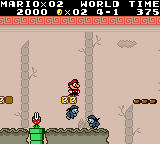 Super Mario Land DX in actionenhancements afforded by the Game Boy Color. The enhancements utilize all 16 colors to flesh out these worlds in a light they’ve never been shown in before, and expertly optimized for real hardware without the need for any extracurricular plug-ins.
Super Mario Land DX in actionenhancements afforded by the Game Boy Color. The enhancements utilize all 16 colors to flesh out these worlds in a light they’ve never been shown in before, and expertly optimized for real hardware without the need for any extracurricular plug-ins.
Examining the technical possibilities of properly modernizing a Game Boy title for current hardware isn’t the only aspect here though; the bigger question is are the games themselves able to stand the test of time twenty years later… While the answer is obviously a resounding yes, some elaboration is in order as to why these specific entries from Mario’s giant catalog of games are some the most innovatively designed, magical experiences to have ever been put out by the Big N.

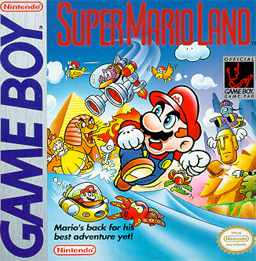 During the infancy of the Game Boy’s development, Nintendo R&D1 headed by Gunpei Yokoi was charged with producing a flagship Mario title for the upcoming platform they were engineering on the heels of Super Mario Bros 3. The mission was a bit of a tall order though, as the team was tasked with creating an authentic entry to the series with only a fifth of the NES’s Visual processing power, and a third of the screen real estate to work with by comparison.
During the infancy of the Game Boy’s development, Nintendo R&D1 headed by Gunpei Yokoi was charged with producing a flagship Mario title for the upcoming platform they were engineering on the heels of Super Mario Bros 3. The mission was a bit of a tall order though, as the team was tasked with creating an authentic entry to the series with only a fifth of the NES’s Visual processing power, and a third of the screen real estate to work with by comparison.
A large component of the fun factor for Super Mario games came from the bright and imaginative settings of the Mushroom Kingdom. The mythical land that’s filled with enemies that ranged from turtle men who threw a swarm of hammers at you to walking Bombs that stalk you with a death march—it’s a distinctive world that’s defined by a signature motif that was difficult to recreate within the limitations of the Game Boy. Recognizing this obstacle, the team decided instead to forego the Mushroom Kingdom altogether and set the stage for Mario’s adventure in an entirely different kingdom in Sarasaland;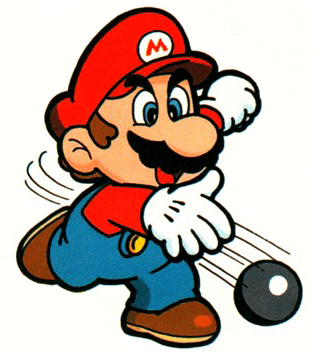 complete with a different princess, and a brand new enemy to thwart. Despite the change in territory, Super Mario Land used the opportunity of new landscapes to their advantage by designing stages around real-life locales around the world, a move that would predate Super Mario Odyssey by 27 years! The settings of Sarasaland take inspiration from Egypt, Atlantis, Easter Islands, and China—each exuding a sense of personality that lends itself really well to the idea of travel—a theme apropos for a mobile game. Design-wise, the first few stages alone feature these exotic backdrops lined with said Egyptian pyramids and desert land that complement the monochrome colors of Nintendo’s portable brilliantly, living up to the larger-than-life visual flair that the Mustachioed hero was famous for in the palm of your hands.
complete with a different princess, and a brand new enemy to thwart. Despite the change in territory, Super Mario Land used the opportunity of new landscapes to their advantage by designing stages around real-life locales around the world, a move that would predate Super Mario Odyssey by 27 years! The settings of Sarasaland take inspiration from Egypt, Atlantis, Easter Islands, and China—each exuding a sense of personality that lends itself really well to the idea of travel—a theme apropos for a mobile game. Design-wise, the first few stages alone feature these exotic backdrops lined with said Egyptian pyramids and desert land that complement the monochrome colors of Nintendo’s portable brilliantly, living up to the larger-than-life visual flair that the Mustachioed hero was famous for in the palm of your hands.
Gameplay-wise, the venture took most of its cues from the original Super Mario Bros, only with a slower pace to its platforming physics and level design to help compensate for the scale of the Handheld’s processing power. Unlike the 1985 classic, Mario doesn’t move with the velocity of a locomotive here, stopping on a dime the moment your thumb releases pressure on the D-Pad. The hangtime of the Plumber's jumps also peak at the apex of his jump, causing him to plummet back down to the ground instantly like a stone, and walking off any ledge will yield the same outcome as well. The more austere approach to Mario’s physics are a little daunting at first, but the excellent level design takes the more rigid movement into mind, and trademark responsiveness in control make for an experience that bears the Mario name well.
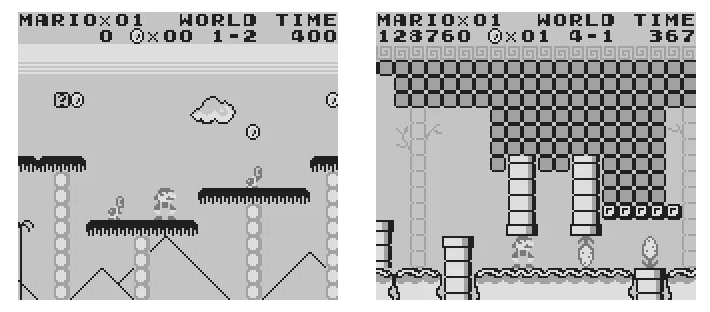 So subtle, yet so expressive; that's the charm of Super Mario Land
So subtle, yet so expressive; that's the charm of Super Mario Land
In addition to the more deliberate stage layouts, Nintendo R&D1 also drew up new enemies that would better accompany the altered pace of the game. Baddies like the Bombshell Koopa, whose packed an explosive shell that would detonate seconds after being stomped on, or the Pompon Flower, an anthropomorphic flower who paces back and forth launching deadly bits of pollen in the air—each one demanding for a tactic that will require a little more platforming skill than your typical Goomba. A new power-up is also introduced in the form of the Super Ball, a lethal sphere that can be lobbed in bouncy 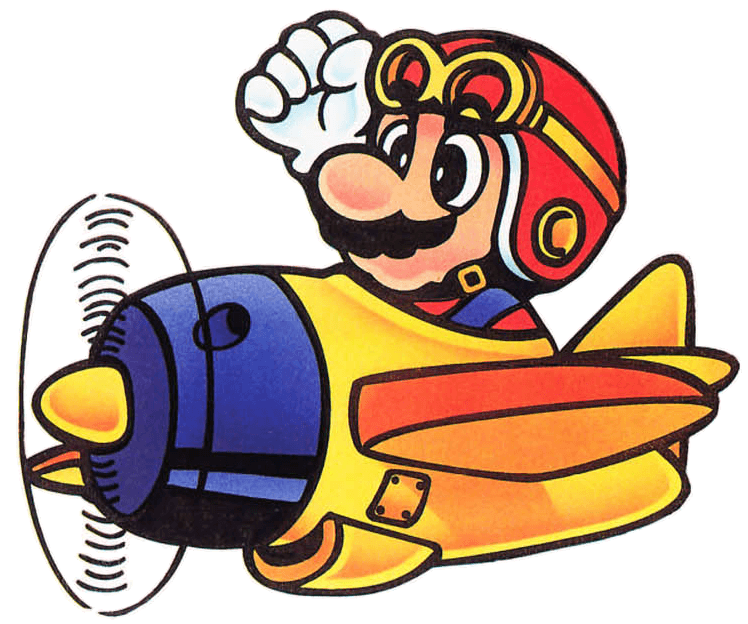 volleys of throughout the stages, ricocheting against any surface it makes contact with until it leaves the screen. Not only are they useful for clearing multiple foes at different angles, but they can also be used to collect coins from long distance just by contact, allowing for a different take to score-chasing not seen in a Mario game before. Easily the most experimental of these new features is the scrolling shoot’em up stages—yeah, you read that right—SHOOTING, STAGES. At the start of the level, Mario will take the helm of a Submarine or biplane, and fire his way through battalions of minions like a level straight out of R-Type—this shit was WILD on a Mario game, and it totally worked—especially for the final showdown with Super Mario Land’s big bad, the heavily-armed Tatanga.
volleys of throughout the stages, ricocheting against any surface it makes contact with until it leaves the screen. Not only are they useful for clearing multiple foes at different angles, but they can also be used to collect coins from long distance just by contact, allowing for a different take to score-chasing not seen in a Mario game before. Easily the most experimental of these new features is the scrolling shoot’em up stages—yeah, you read that right—SHOOTING, STAGES. At the start of the level, Mario will take the helm of a Submarine or biplane, and fire his way through battalions of minions like a level straight out of R-Type—this shit was WILD on a Mario game, and it totally worked—especially for the final showdown with Super Mario Land’s big bad, the heavily-armed Tatanga.
The biggest downside to Super Mario Land is its fleeting game length as the adventure comes to an end after 12 short-lived stages of action, weighing heavily towards quality over quantity—which is fine, but definitely left a lot of players with an appetite for more, especially after only hour or so of unique gameplay.
It would be a long three-year wait before Game Boy owners would get a new Mario title for the Brick-sized console, and man, oh MAN was the wait just so ever worth it.

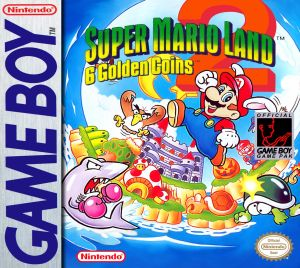 In 1992, the Game Boy had already hosted over 250 games, steadily becoming a household name in Video Games. The success of the system also gave programmers the chance to familiarize themselves more with the nuances of the platform’s tech, paving the way for Nintendo R&D1 to deliver the next big Mario title in the era of 16-bit gaming.
In 1992, the Game Boy had already hosted over 250 games, steadily becoming a household name in Video Games. The success of the system also gave programmers the chance to familiarize themselves more with the nuances of the platform’s tech, paving the way for Nintendo R&D1 to deliver the next big Mario title in the era of 16-bit gaming.
Super Mario Land 2: 6 Golden Coins isn’t just the definition of the perfect sequel—it was also a technical showcase on what the Game Boy could offer against its more technically-advanced peers, the Sega Game Gear and the Atari Lynx.
Employing the talents of Metroid’s Hiroji Kiyotake, R&D1 brought in some more cooks to its kitchen to bake a sequel that delivered new confections to the Mario formula while mainlining the iconic platforming flavor. Continuing the trend of setting itself environment apart from the Mushroom Kingdom, Super Mario Land 2 actually takes place in “Mario Land,” a private little kingdom that Mario owns all to himself, with six unique zones that make up the egocentric capital. A neat touch in this entry, however, is that the quest isn’t about saving a damsel in distress, but reclaiming your land back by a certain doppelganger who would make his humble debut. Nintendo’s future meme-lord, Wario comes into the picture to declare Manifest Destiny on Mario’s property while the Big M is away, and had sealed off the entrance to his castle with a special lock that uses Six Gold Coins as keys to gain entry.
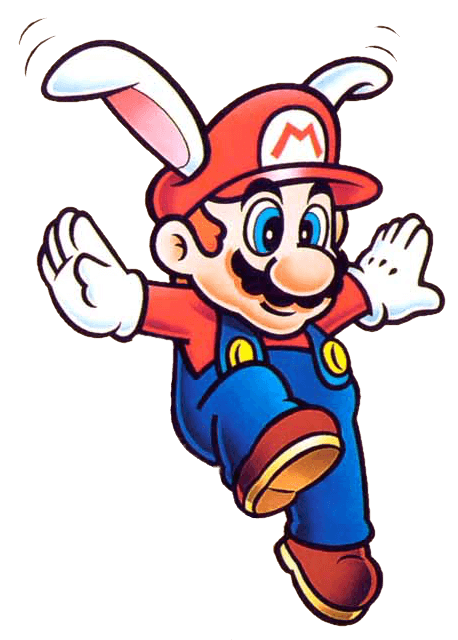 On the presentation front, Super Mario Land 2 is leaps and bounds more advanced than its predecessor, featuring sharp sprite work and background detail that can almost stand toe-to-toe with the latest entry to the Plumber’s franchise, Super Mario World. Each stage is uniquely designed to show off little flourishes that are impressive for the hardware, like animated backgrounds/foregrounds and pseudo transparency effects that add a whole new layer of life to the action on-screen.
On the presentation front, Super Mario Land 2 is leaps and bounds more advanced than its predecessor, featuring sharp sprite work and background detail that can almost stand toe-to-toe with the latest entry to the Plumber’s franchise, Super Mario World. Each stage is uniquely designed to show off little flourishes that are impressive for the hardware, like animated backgrounds/foregrounds and pseudo transparency effects that add a whole new layer of life to the action on-screen.
The added detail for the in-game graphics also allow for more advanced power-ups and enemies to interact with. The Super Carrot for example gives Mario giant Bunny Ears from his Cap that he can use to gently slow the descent of his jumps, or how about a Goomba-like baddies that wear Hockey Goalie Masks, complete with a Machete sticking out of their skull. The name of that weird little crony you ask?—I am not making this up: J-son, the name of this enemy is J-son. The six zones are crafted with the same kind of personality as you’ll trek through “Zones” like Turtle Zone, an area that takes place entirely within a giant Koopa-Troopa, or Macro Zone, a Bird House that shrinks the Jumping Mustache to the size of an insect à la “Honey, I Shrunk the Kids” style. The eccentric direction is just wacky enough to pump a ton of charm into Blue-Collar protagonist’s second Game Boy title without straying too far out the Mario Orbit so to speak.
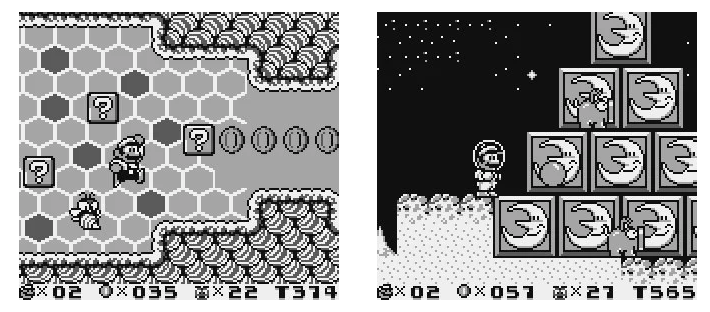 The worlds of Super Mario Land 2: Six Golden Coins have an incredible personality.
The worlds of Super Mario Land 2: Six Golden Coins have an incredible personality.
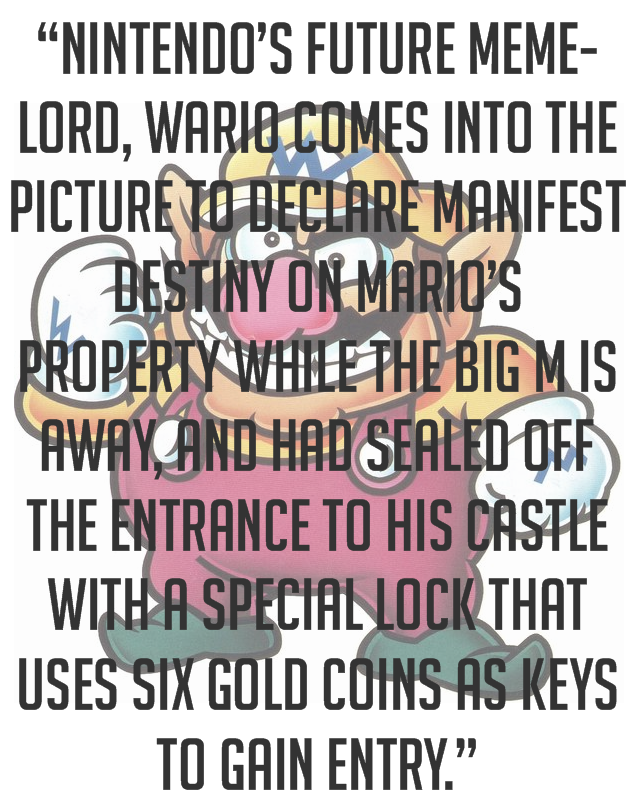 Even so, for as different as SML2 is, it’s pleasantly more familiar than the previous entry was with Koopa-Troopas, Goombas, and Fire-Flowers make a return this go-around. Some of the newer gameplay elements that were featured in Super Mario Bros 3 and Super Mario World also make an appearance here like Mario’s Spin-Jump technique that breakdown specific blocks or enemies, and an Overworld that Mario can move around on—complete with branching paths that allow for non-linear level progression as well.
Even so, for as different as SML2 is, it’s pleasantly more familiar than the previous entry was with Koopa-Troopas, Goombas, and Fire-Flowers make a return this go-around. Some of the newer gameplay elements that were featured in Super Mario Bros 3 and Super Mario World also make an appearance here like Mario’s Spin-Jump technique that breakdown specific blocks or enemies, and an Overworld that Mario can move around on—complete with branching paths that allow for non-linear level progression as well.
The length is triple that of the original Super Mario Land’s as well, with stages that sprawl across multiple screens that even make use of a checkpoint similar to SMW. If the size weren’t enough, the campaign features a whopping 32 levels across the six zones, each zone managed by a boss that’s guarding one of the pivotal Gold Coins. With the adventure in SML2: Six Gold Coins being three times the size of Super Mario Land, R&D1 wisely included a Save feature, making it easier to digest the additional playtime beyond a single sitting. The difficulty is fairly manageable, especially for Mario veterans, though there is a rather cruel challenge that’s more sinister than any other Mario title before i. If a player were to lose all of Mario’s lives at any point prior to unlocking the Castle Door of the final stage, they will lose every Gold Coin they collected and will need to beat the bosses guarding them all over again in order to reclaim them.
Overall, Super Mario Land 2: SGC isn’t just one of the best Mario games available today, it’s one of the best Game Boy games the library has to offer, becoming one of the most critically acclaimed titles in the franchise with over 11 million copies.
While I love Super Mario Land 2 with all of my heart, I don’t consider It the best Mario game on the Game Boy; for my money, that honor goes to Game Boy Donkey Kong, or Donkey Kong ’94—the absolute Dark Horse of the three!

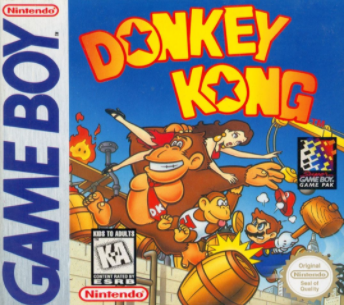 Now I know what you’re thinking after just reading that last sentence; “Uhhh George, you stupid dumb idiot, Donkey Kong ‘94 isn’t a Super Mario Land game, hell it isn’t even a MARIO game!” I hear you, and believe me, there’s a method to this madness. First off, Super Mario Land 3: Wario Land isn’t a sequel to an existing series, but the back-door pilot to a brand new one that’s worthy of its own editorial (Seriously, just take a second to fantasize the possibility of a Wario Land Collection, and you’ll get what I mean.) Secondly, this wonderful little gem of a game is a Mario-ass Mario title through and through, doing things with the “Jumpman” concept that has gone on to redefine the platforming physics of the mainstream titles you know and love to this very DAY.
Now I know what you’re thinking after just reading that last sentence; “Uhhh George, you stupid dumb idiot, Donkey Kong ‘94 isn’t a Super Mario Land game, hell it isn’t even a MARIO game!” I hear you, and believe me, there’s a method to this madness. First off, Super Mario Land 3: Wario Land isn’t a sequel to an existing series, but the back-door pilot to a brand new one that’s worthy of its own editorial (Seriously, just take a second to fantasize the possibility of a Wario Land Collection, and you’ll get what I mean.) Secondly, this wonderful little gem of a game is a Mario-ass Mario title through and through, doing things with the “Jumpman” concept that has gone on to redefine the platforming physics of the mainstream titles you know and love to this very DAY.
Helmed by a different development team in the Nintendo house, Nintendo EAD, Donkey Kong ’94 was unique for a number of reasons. It was the first time Nintendo had reimagined one of their properties, as it had been over 11 years since Mario had fought with the big ape and family in Donkey Kong Jr. It was also chosen to be one of the first Super Game Boy enhanced titles available for the new peripheral, an add-on cartridge that for the Super NES that when connected with a Game Boy title, would allow players to play that game on their Television with a SNES controller and all.
The enhancements would include expanded sound, a larger color palette, and a unique border that would fill the extra screen real estate around the 160 x 144 Pixel window of the game. Super Game Boy enhancements aside, the game in its own right is no slouch when played on its proprietary handheld. Developed well into the prime of the Game Boy’s life, Donkey Kong ’94 features some of the sharpest design seen for the system, with a slew of unique animations and sprites stretched across 40 unique characters that are spread throughout 10 distinctive worlds containing a staggering total of 101 stages. Duping players with a bait-and-switch four levels in, Donkey Kong rises like a smelly phoenix soaring upward from the ashes of defeat, to nab the Future New Donk City Mayor and lumber off into the city where players will give chase to a tour de force of a kidnapping.
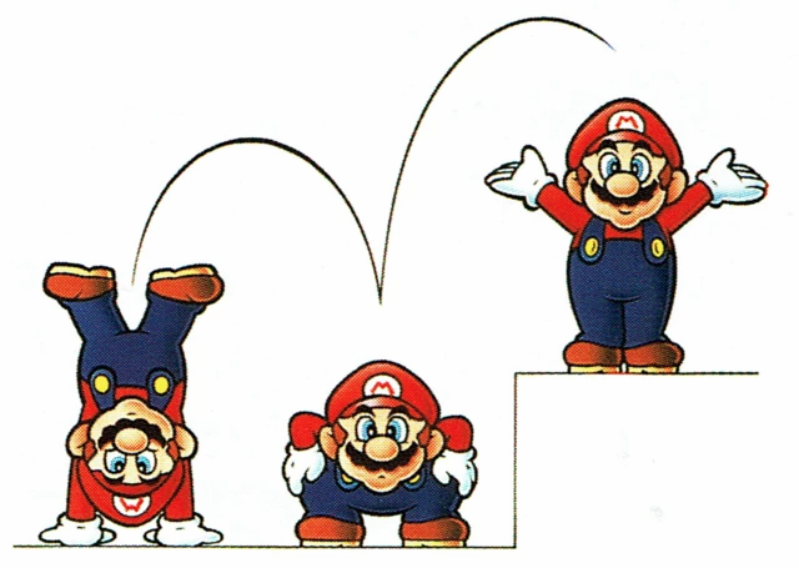
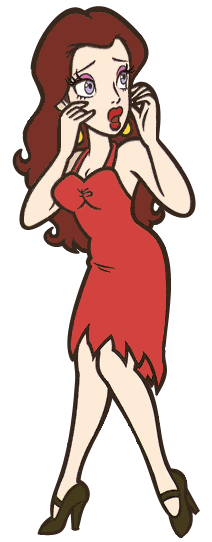 Unlike the previous Mario Land titles, Donkey King ’94 is a melting pot of Mario’s Arcade roots, with a few added improvements from his more recent platforming ventures. Taking cues from Donkey Kong, Donkey Kong Jr, Mario Bros, and even Super Mario Bros 2 to some respect, each stage is presented in a Single-Screen format where players will need to complete various puzzles to get access to the key that unlocks the exit door of the level. The platforming physics a slightly more enhanced approach to his Jumping skills from his Girder and ladder days. For example, while the apex of his jumping height is still determined by the pressure of the button input, the aerodynamic flow of his airtime is slow and stocky, reminiscent of games like Super Ghouls ‘n Ghosts or Super Castlevania IV, giving little to no room for course-correction against any of the platforming hazards encountered. The movement of the Mustached wonder is also much stockier in his movement, and doesn’t run anywhere near the speed we’ve seen from him out of previous platformers—he can even die from fall damage in this outing like the original Donkey Kong arcade title, albeit from a
Unlike the previous Mario Land titles, Donkey King ’94 is a melting pot of Mario’s Arcade roots, with a few added improvements from his more recent platforming ventures. Taking cues from Donkey Kong, Donkey Kong Jr, Mario Bros, and even Super Mario Bros 2 to some respect, each stage is presented in a Single-Screen format where players will need to complete various puzzles to get access to the key that unlocks the exit door of the level. The platforming physics a slightly more enhanced approach to his Jumping skills from his Girder and ladder days. For example, while the apex of his jumping height is still determined by the pressure of the button input, the aerodynamic flow of his airtime is slow and stocky, reminiscent of games like Super Ghouls ‘n Ghosts or Super Castlevania IV, giving little to no room for course-correction against any of the platforming hazards encountered. The movement of the Mustached wonder is also much stockier in his movement, and doesn’t run anywhere near the speed we’ve seen from him out of previous platformers—he can even die from fall damage in this outing like the original Donkey Kong arcade title, albeit from a 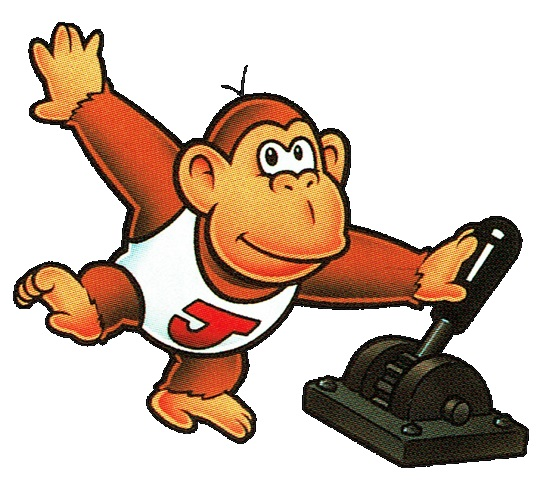 much higher distance this time around. Keeping in line with the DK outline, the only power-ups in the game are the traditional Hammer and Super Hammer; however, EAD did step up Mario’s arsenal with the addition of acrobatic moves and jumps that he can use to navigate the traps and puzzles left behind by the nefarious ape.
much higher distance this time around. Keeping in line with the DK outline, the only power-ups in the game are the traditional Hammer and Super Hammer; however, EAD did step up Mario’s arsenal with the addition of acrobatic moves and jumps that he can use to navigate the traps and puzzles left behind by the nefarious ape.
In addition to his standard jump, holding down on the D-Pad while jumping will cause the Plumber to flip into a handstand where he can move around on his mitts, allowing for some overhead defense against any falling objects like Barrels or Tire Rims that would normally kill him on contact by kicking them off to the side. The handstand technique can also be used to set up Mario’s triple jump maneuver, by immediately pressing the “A” button again the moment his palms hit the ground, and then hitting “A” once more on the second dismount ascend with a significantly higher leap then his usual hopping height. The other platforming skill available is his Sidestep jump, a move that will allow Mario to do a running backflip behind him by pressing the opposite direction he’s running towards on the D-Pad and the “A” Button simultaneously, allowing for some split-second vertical traversal that a normal jump wouldn’t be able to handle.
These two specific skills alone do a lot to recoup the momentum that’s lost with Mario’s more sluggish cadence, balancing the Nintendo mascot on a fine line between his “Super” physics and “Arcade” physics—in fact, they were so well received that they were reworked into the iconic Triple jump and Side flip jumps seen in Super Mario 64! The Italian Stallion may not have access to Super Mushrooms or Fire Flowers, but he does seem to recall his time of REM Sleep in Subcon as players will have access to lifting up items over his head like he did in Super Mario Bros 2. The items can be anything from Barrels, Trash Cans to Keyes, and even some enemies over his head, carrying and tossing anything you’d like around like a garden-variety turnip. Acclimating to Mario’s unique control scheme in DK ‘94 is an easy enough task thanks largely in part to the excellent level design, and players will need every trick available to overcome the deceptively challenging puzzles in store.
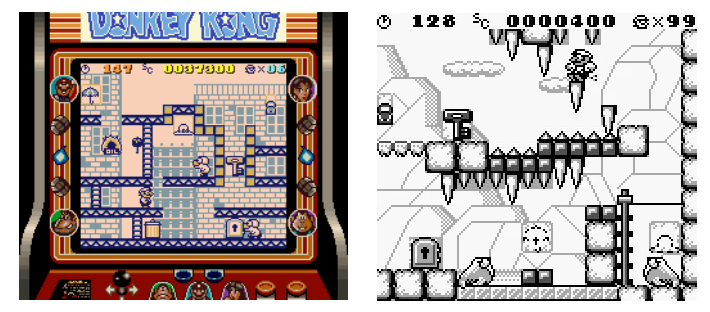 Donkey Kong '94 looks amazing on the Super Game Boy, and on a native Game Boy display.
Donkey Kong '94 looks amazing on the Super Game Boy, and on a native Game Boy display.
Every world introduces various gimmicks that revolve around some degree of platforming physics that will hide a unique solution more differently than the last puzzle. These mechanics range from makeshift platforms and ladders that can be placed anywhere under a set time limit, to Lever switches that will open and close various platforms and doors. Each new dynamic is introduced with an immaculate sense of pacing that makes use of some previous explication into a step that works itself into a new answer to the current trial. Let me put it this way; imagine every puzzle you’ve ever encountered in games today like Braid, Limbo, or even FEZ—Donkey Kong ’94 paved the way for them all, and pioneered the subgenre of puzzle platformers in ways that contemporaries like Lode Runner or Another World could never inspire.
Seriously, Donkey Kong ’94 is so much more than the sum of its parts, and is handily the best-aged game of the three, but hey, why stop there.

If we’re going to make this a collection that celebrates most of the Main Man’s mobile adventures, then why not dive into Nintendo “Other” Boy—you know the one; it had a bad habit of getting in your face all the time, and only saw the world in Black and Red—yeah that’s right, I’m talking about the Nintendo Virtual Boy.
But why did I bring up one of the Big N’s most embarrassing blunders here and now you ask?—because out of the 22 games released for the damn thing, there was a unique little Mario title that deserves just as much love named Mario Clash. Nothing would make this Game Boy collection more special than an unlockable nod to the Whisker-lipped Wonder’s first 32-bit gaiden.

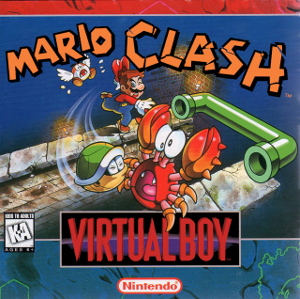 Before I go any further, I’d like to quickly cover why emulating the Virtual Boy is still possible on a modern platform that ISN’T the 3DS, and could absolutely be done on the Nintendo Switch.
Before I go any further, I’d like to quickly cover why emulating the Virtual Boy is still possible on a modern platform that ISN’T the 3DS, and could absolutely be done on the Nintendo Switch.
In 2018, a famed modder in the retro gaming community by the name of Furrtek who sought out a way to give faulty Virtual Boys that can’t display correctly anymore a second life on a bonafide Television screen. Furrtek designed an external video board that he aptly named the Virtual Tap that when installed, will tap the video signal and transmit an RGB quality video to either a digital or analog display. Not only could it display in digital or analog, but it also made use of the quasi portable’s widescreen capabilities, allowing for pixel-perfect scaling in 16:9! The modder also added a slew of other color arrangements to use instead of the infamous red-and-black scheme, giving access to something more akin to the original Game Boy like black-and-white, or a bunch of other Game Boy Color-esque hues that made use of primary color over lighter contrasts, like purple, or green.
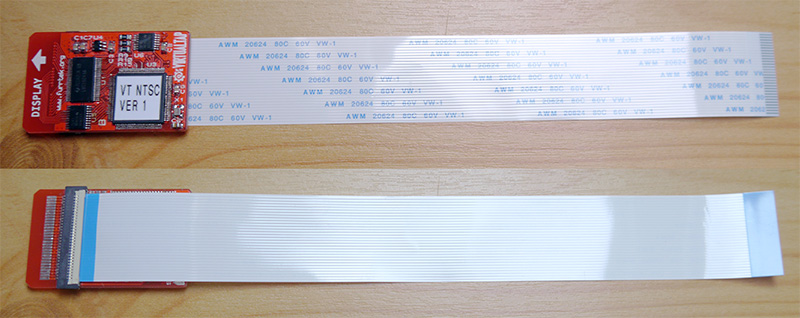 The "Virtual Tap" mod from Furrtek allows for direct video capture onto an external display with the Virtual Boy and so much more.
The "Virtual Tap" mod from Furrtek allows for direct video capture onto an external display with the Virtual Boy and so much more.
It’s important to highlight this mod because beyond the video capture potential it lends to the machine, it uncovers the surprisingly groundbreaking video tech that’s capable of adapting to current display standards—which in turn, makes it even easier to emulate the Virtual Boy on something as sophisticated as the Nintendo Switch. The only sticky aspect to this proposition is the omission of the VB’s signature feature; 3D visuals. There is one slight workaround to this though; the added vertical resolution of the Switch could use its depth of field to simulate the Virtual Boy’s standard 800X600 output, which isn’t perfect by any means but still a possibility to recreate the 3D effects nonetheless.
The Three-dimensional effects are somewhat of an important element to the specific dynamics of Mario Clash as the Unit’s oscillating mirrors reflect an illusory depth over the various planes on-screen to create a false sense of distance between them, making the stage appear far more panoramic than it actually is. The game is certainly playable in flat 2D, but it certainly loses a significant degree of its spectacle in the process—even so, the question is no longer “how”, but rather “when”, and there’s no better time to do it than with this nearly forgotten title. Mario Clash is more than the Plumber’s only solo venture on the platform, and totally deserves to be included as a bonus, because not only does it makes for a great curio, but it’s a wonderfully fine game in its own right.
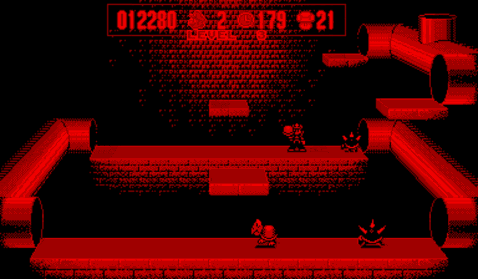
Using the same concept as Donkey Long ’94, Mario Clash is a spin on the classic arcade title, Mario Bros, where the Portly Superstar will be tasked exterminating pests until they’re all dead, level by level. The twist in this iteration is the added perspective of the background and foreground being used for dynamic areas of the level, displaying the field though a semi-isometric angle via a hard camera view.
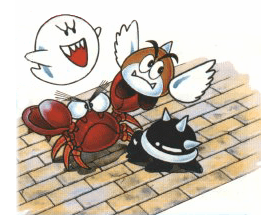 Instead of jumping back and forth between three stories of platforms, the level is designed with 2.5 architecture that will allow players passage between the forefront and rear of the stage, with varying stories of verticality thrown in as the game progresses. Instead of defeating enemies by striking them the platform below them, however, Mario now relies on the appearance of Koopa-Troopas wandering the level, where defeating them will grant access to their shell in order to launch it at the baddies swarming the stage, only now with the added ability to send it flying in four directions instead of two. The additional axis gives way to some unconventional tactics for goons who won’t go down with the usual front-on assault. Whether it’s a Boo that needs to be struck from behind while your back is turned or a Black Spikey that’s only vulnerable from the sides, each new enemy introduces a new complex weakness to find as a clever puzzle to solve.
Instead of jumping back and forth between three stories of platforms, the level is designed with 2.5 architecture that will allow players passage between the forefront and rear of the stage, with varying stories of verticality thrown in as the game progresses. Instead of defeating enemies by striking them the platform below them, however, Mario now relies on the appearance of Koopa-Troopas wandering the level, where defeating them will grant access to their shell in order to launch it at the baddies swarming the stage, only now with the added ability to send it flying in four directions instead of two. The additional axis gives way to some unconventional tactics for goons who won’t go down with the usual front-on assault. Whether it’s a Boo that needs to be struck from behind while your back is turned or a Black Spikey that’s only vulnerable from the sides, each new enemy introduces a new complex weakness to find as a clever puzzle to solve.
Granted, while the hook is unique, it only has so much draw before the gameplay starts to get a bit long in the tooth, especially when the campaign advances past the fiftieth stage. Despite the repetitive gameplay at its core, there’s an old-fashioned arcade game here that makes for a great pick and play option in a collection that’s packed with so many deep games by comparison.

In an age before the rise of more advanced hardware like the Nintendo DS and the Sony PSP revolutionized portable gaming, mobile games carried the reputations of being nothing more than watered-down versions of their console cousins—these titles managed to defy those expectations, raising the bar higher for what kind of quality a portable game can actually offer.
Aside from the Virtual Console re-releases on Nintendo 3DS, the only fanfare these titles have received from Nintendo is a passing mention at best, and well, there’s honestly no excuse for it. These titles carry such a heavy legacy for not just the Game Boy, but the character Mario himself. There’s a quote that gets thrown around a lot that limitation breeds creativity, and it’s easy to see that philosophy is heavily woven into the inner framework of Nintendo’s handheld; this mantra forced the Big N to be the most experimental they could with the Mascot, and thirty years later, the results are still paying dividends for the Plumber. It’s a shame that Nintendo hasn’t bothered with cashing in on the value these games hold, but if the upcoming 3D Collection gets enough traction, then there may still be hope yet for this wistful list of wishful thinking…





 GeorgieBoysAXE
GeorgieBoysAXE




